Kuicai Dong
Doc-Researcher: A Unified System for Multimodal Document Parsing and Deep Research
Oct 24, 2025Abstract:Deep Research systems have revolutionized how LLMs solve complex questions through iterative reasoning and evidence gathering. However, current systems remain fundamentally constrained to textual web data, overlooking the vast knowledge embedded in multimodal documents Processing such documents demands sophisticated parsing to preserve visual semantics (figures, tables, charts, and equations), intelligent chunking to maintain structural coherence, and adaptive retrieval across modalities, which are capabilities absent in existing systems. In response, we present Doc-Researcher, a unified system that bridges this gap through three integrated components: (i) deep multimodal parsing that preserves layout structure and visual semantics while creating multi-granular representations from chunk to document level, (ii) systematic retrieval architecture supporting text-only, vision-only, and hybrid paradigms with dynamic granularity selection, and (iii) iterative multi-agent workflows that decompose complex queries, progressively accumulate evidence, and synthesize comprehensive answers across documents and modalities. To enable rigorous evaluation, we introduce M4DocBench, the first benchmark for Multi-modal, Multi-hop, Multi-document, and Multi-turn deep research. Featuring 158 expert-annotated questions with complete evidence chains across 304 documents, M4DocBench tests capabilities that existing benchmarks cannot assess. Experiments demonstrate that Doc-Researcher achieves 50.6% accuracy, 3.4xbetter than state-of-the-art baselines, validating that effective document research requires not just better retrieval, but fundamentally deep parsing that preserve multimodal integrity and support iterative research. Our work establishes a new paradigm for conducting deep research on multimodal document collections.
Humanity's Last Code Exam: Can Advanced LLMs Conquer Human's Hardest Code Competition?
Jun 15, 2025Abstract:Code generation is a core capability of large language models (LLMs), yet mainstream benchmarks (e.g., APPs and LiveCodeBench) contain questions with medium-level difficulty and pose no challenge to advanced LLMs. To better reflected the advanced reasoning and code generation ability, We introduce Humanity's Last Code Exam (HLCE), comprising 235 most challenging problems from the International Collegiate Programming Contest (ICPC World Finals) and the International Olympiad in Informatics (IOI) spanning 2010 - 2024. As part of HLCE, we design a harmonized online-offline sandbox that guarantees fully reproducible evaluation. Through our comprehensive evaluation, we observe that even the strongest reasoning LLMs: o4-mini(high) and Gemini-2.5 Pro, achieve pass@1 rates of only 15.9% and 11.4%, respectively. Meanwhile, we propose a novel "self-recognition" task to measure LLMs' awareness of their own capabilities. Results indicate that LLMs' self-recognition abilities are not proportionally correlated with their code generation performance. Finally, our empirical validation of test-time scaling laws reveals that current advanced LLMs have substantial room for improvement on complex programming tasks. We expect HLCE to become a milestone challenge for code generation and to catalyze advances in high-performance reasoning and human-AI collaborative programming. Our code and dataset are also public available(https://github.com/Humanity-s-Last-Code-Exam/HLCE).
Benchmarking Retrieval-Augmented Multimomal Generation for Document Question Answering
May 22, 2025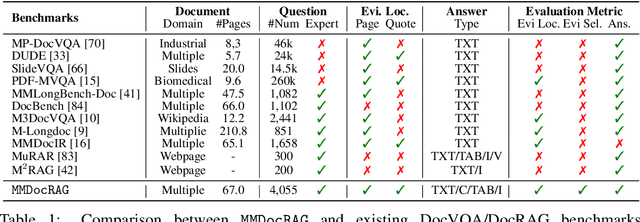
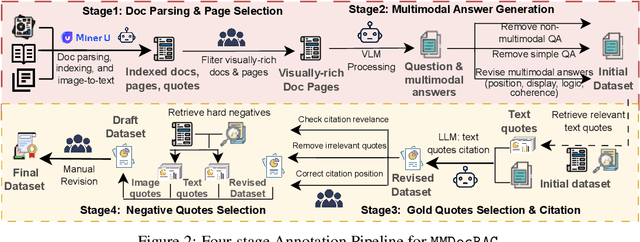
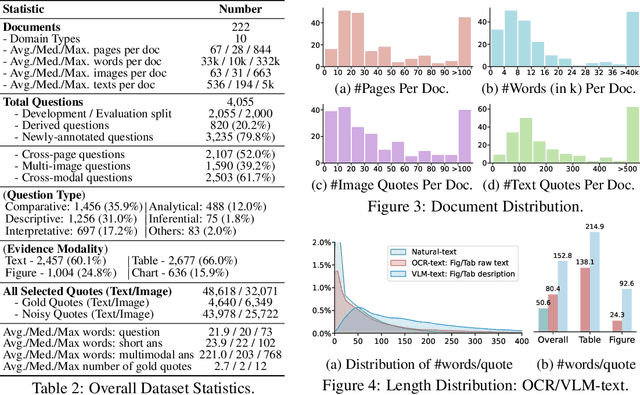
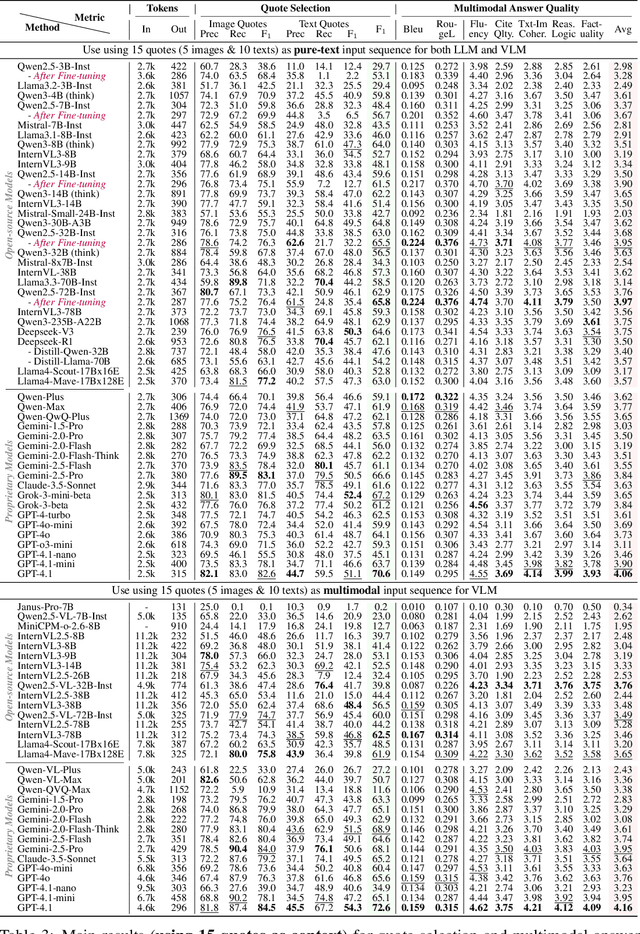
Abstract:Document Visual Question Answering (DocVQA) faces dual challenges in processing lengthy multimodal documents (text, images, tables) and performing cross-modal reasoning. Current document retrieval-augmented generation (DocRAG) methods remain limited by their text-centric approaches, frequently missing critical visual information. The field also lacks robust benchmarks for assessing multimodal evidence selection and integration. We introduce MMDocRAG, a comprehensive benchmark featuring 4,055 expert-annotated QA pairs with multi-page, cross-modal evidence chains. Our framework introduces innovative metrics for evaluating multimodal quote selection and enables answers that interleave text with relevant visual elements. Through large-scale experiments with 60 VLM/LLM models and 14 retrieval systems, we identify persistent challenges in multimodal evidence retrieval, selection, and integration.Key findings reveal advanced proprietary LVMs show superior performance than open-sourced alternatives. Also, they show moderate advantages using multimodal inputs over text-only inputs, while open-source alternatives show significant performance degradation. Notably, fine-tuned LLMs achieve substantial improvements when using detailed image descriptions. MMDocRAG establishes a rigorous testing ground and provides actionable insights for developing more robust multimodal DocVQA systems. Our benchmark and code are available at https://mmdocrag.github.io/MMDocRAG/.
Process vs. Outcome Reward: Which is Better for Agentic RAG Reinforcement Learning
May 20, 2025Abstract:Retrieval-augmented generation (RAG) enhances the text generation capabilities of large language models (LLMs) by integrating external knowledge and up-to-date information. However, traditional RAG systems are limited by static workflows and lack the adaptability required for multistep reasoning and complex task management. To address these limitations, agentic RAG systems (e.g., DeepResearch) have been proposed, enabling dynamic retrieval strategies, iterative context refinement, and adaptive workflows for handling complex search queries beyond the capabilities of conventional RAG. Recent advances, such as Search-R1, have demonstrated promising gains using outcome-based reinforcement learning, where the correctness of the final answer serves as the reward signal. Nevertheless, such outcome-supervised agentic RAG methods face challenges including low exploration efficiency, gradient conflict, and sparse reward signals. To overcome these challenges, we propose to utilize fine-grained, process-level rewards to improve training stability, reduce computational costs, and enhance efficiency. Specifically, we introduce a novel method ReasonRAG that automatically constructs RAG-ProGuide, a high-quality dataset providing process-level rewards for (i) query generation, (ii) evidence extraction, and (iii) answer generation, thereby enhancing model inherent capabilities via process-supervised reinforcement learning. With the process-level policy optimization, the proposed framework empowers LLMs to autonomously invoke search, generate queries, extract relevant evidence, and produce final answers. Compared to existing approaches such as Search-R1 and traditional RAG systems, ReasonRAG, leveraging RAG-ProGuide, achieves superior performance on five benchmark datasets using only 5k training instances, significantly fewer than the 90k training instances required by Search-R1.
Adaptive Tool Use in Large Language Models with Meta-Cognition Trigger
Feb 18, 2025



Abstract:Large language models (LLMs) have shown remarkable emergent capabilities, transforming the execution of functional tasks by leveraging external tools for complex problems that require specialized processing or real-time data. While existing research expands LLMs access to diverse tools (e.g., program interpreters, search engines, weather/map apps), the necessity of using these tools is often overlooked, leading to indiscriminate tool invocation. This naive approach raises two key issues:(1) increased delays due to unnecessary tool calls, and (2) potential errors resulting from faulty interactions with external tools. In this paper, we introduce meta-cognition as a proxy for LLMs self-assessment of their capabilities, representing the model's awareness of its own limitations. Based on this, we propose MeCo, an adaptive decision-making strategy for external tool use. MeCo quantifies metacognitive scores by capturing high-level cognitive signals in the representation space, guiding when to invoke tools. Notably, MeCo is fine-tuning-free and incurs minimal cost. Our experiments show that MeCo accurately detects LLMs' internal cognitive signals and significantly improves tool-use decision-making across multiple base models and benchmarks.
MMDocIR: Benchmarking Multi-Modal Retrieval for Long Documents
Jan 15, 2025



Abstract:Multi-modal document retrieval is designed to identify and retrieve various forms of multi-modal content, such as figures, tables, charts, and layout information from extensive documents. Despite its significance, there is a notable lack of a robust benchmark to effectively evaluate the performance of systems in multi-modal document retrieval. To address this gap, this work introduces a new benchmark, named as MMDocIR, encompassing two distinct tasks: page-level and layout-level retrieval. The former focuses on localizing the most relevant pages within a long document, while the latter targets the detection of specific layouts, offering a more fine-grained granularity than whole-page analysis. A layout can refer to a variety of elements such as textual paragraphs, equations, figures, tables, or charts. The MMDocIR benchmark comprises a rich dataset featuring expertly annotated labels for 1,685 questions and bootstrapped labels for 173,843 questions, making it a pivotal resource for advancing multi-modal document retrieval for both training and evaluation. Through rigorous experiments, we reveal that (i) visual retrievers significantly outperform their text counterparts, (ii) MMDocIR train set can effectively benefit the training process of multi-modal document retrieval and (iii) text retrievers leveraging on VLM-text perform much better than those using OCR-text. These findings underscores the potential advantages of integrating visual elements for multi-modal document retrieval.
Collaborative Cross-modal Fusion with Large Language Model for Recommendation
Aug 16, 2024



Abstract:Despite the success of conventional collaborative filtering (CF) approaches for recommendation systems, they exhibit limitations in leveraging semantic knowledge within the textual attributes of users and items. Recent focus on the application of large language models for recommendation (LLM4Rec) has highlighted their capability for effective semantic knowledge capture. However, these methods often overlook the collaborative signals in user behaviors. Some simply instruct-tune a language model, while others directly inject the embeddings of a CF-based model, lacking a synergistic fusion of different modalities. To address these issues, we propose a framework of Collaborative Cross-modal Fusion with Large Language Models, termed CCF-LLM, for recommendation. In this framework, we translate the user-item interactions into a hybrid prompt to encode both semantic knowledge and collaborative signals, and then employ an attentive cross-modal fusion strategy to effectively fuse latent embeddings of both modalities. Extensive experiments demonstrate that CCF-LLM outperforms existing methods by effectively utilizing semantic and collaborative signals in the LLM4Rec context.
CoIR: A Comprehensive Benchmark for Code Information Retrieval Models
Jul 03, 2024



Abstract:Despite the substantial success of Information Retrieval (IR) in various NLP tasks, most IR systems predominantly handle queries and corpora in natural language, neglecting the domain of code retrieval. Code retrieval is critically important yet remains under-explored, with existing methods and benchmarks inadequately representing the diversity of code in various domains and tasks. Addressing this gap, we present \textbf{\name} (\textbf{Co}de \textbf{I}nformation \textbf{R}etrieval Benchmark), a robust and comprehensive benchmark specifically designed to assess code retrieval capabilities. \name comprises \textbf{ten} meticulously curated code datasets, spanning \textbf{eight} distinctive retrieval tasks across \textbf{seven} diverse domains. We first discuss the construction of \name and its diverse dataset composition. Further, we evaluate nine widely used retrieval models using \name, uncovering significant difficulties in performing code retrieval tasks even with state-of-the-art systems. To facilitate easy adoption and integration within existing research workflows, \name has been developed as a user-friendly Python framework, readily installable via pip. It shares same data schema as other popular benchmarks like MTEB and BEIR, enabling seamless cross-benchmark evaluations. Through \name, we aim to invigorate research in the code retrieval domain, providing a versatile benchmarking tool that encourages further development and exploration of code retrieval systems\footnote{\url{ https://github.com/CoIR-team/coir}}.
CtrlA: Adaptive Retrieval-Augmented Generation via Probe-Guided Control
May 29, 2024



Abstract:Retrieval-augmented generation (RAG) has emerged as a promising solution for mitigating hallucinations of large language models (LLMs) with retrieved external knowledge. Adaptive RAG enhances this approach by dynamically assessing the retrieval necessity, aiming to balance external and internal knowledge usage. However, existing adaptive RAG methods primarily realize retrieval on demand by relying on superficially verbalize-based or probability-based feedback of LLMs, or directly fine-tuning LLMs via carefully crafted datasets, resulting in unreliable retrieval necessity decisions, heavy extra costs, and sub-optimal response generation. We present the first attempts to delve into the internal states of LLMs to mitigate such issues by introducing an effective probe-guided adaptive RAG framework, termed CtrlA. Specifically, CtrlA employs an honesty probe to regulate the LLM's behavior by manipulating its representations for increased honesty, and a confidence probe to monitor the internal states of LLM and assess confidence levels, determining the retrieval necessity during generation. Experiments show that CtrlA is superior to existing adaptive RAG methods on a diverse set of tasks, the honesty control can effectively make LLMs more honest and confidence monitoring is proven to be a promising indicator of retrieval trigger. Our codes are available at https://github.com/HSLiu-Initial/CtrlA.git.
Multi-view Content-aware Indexing for Long Document Retrieval
Apr 23, 2024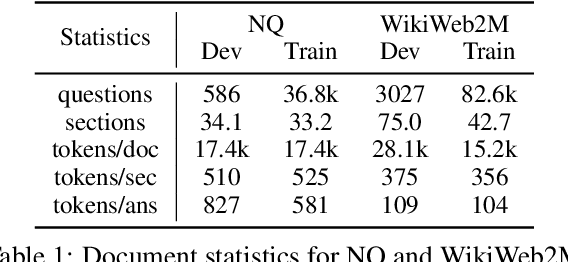
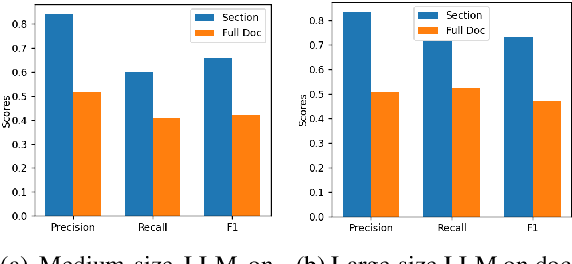
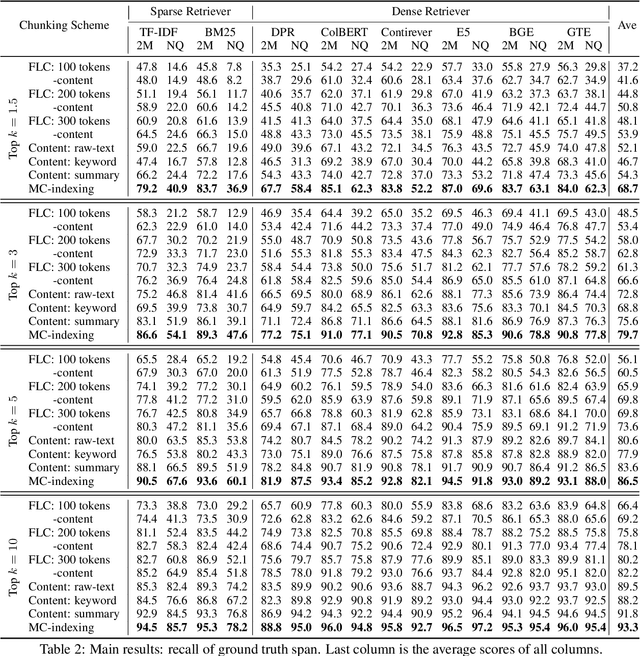
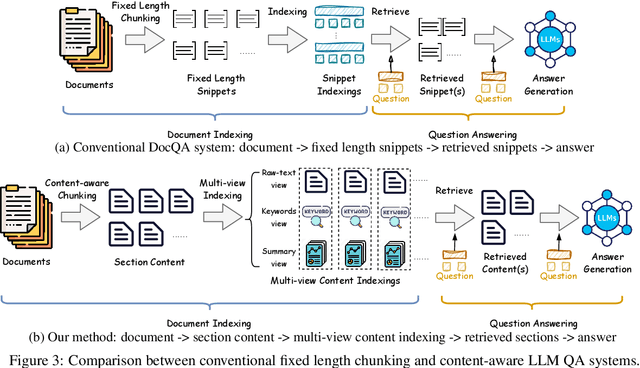
Abstract:Long document question answering (DocQA) aims to answer questions from long documents over 10k words. They usually contain content structures such as sections, sub-sections, and paragraph demarcations. However, the indexing methods of long documents remain under-explored, while existing systems generally employ fixed-length chunking. As they do not consider content structures, the resultant chunks can exclude vital information or include irrelevant content. Motivated by this, we propose the Multi-view Content-aware indexing (MC-indexing) for more effective long DocQA via (i) segment structured document into content chunks, and (ii) represent each content chunk in raw-text, keywords, and summary views. We highlight that MC-indexing requires neither training nor fine-tuning. Having plug-and-play capability, it can be seamlessly integrated with any retrievers to boost their performance. Besides, we propose a long DocQA dataset that includes not only question-answer pair, but also document structure and answer scope. When compared to state-of-art chunking schemes, MC-indexing has significantly increased the recall by 42.8%, 30.0%, 23.9%, and 16.3% via top k= 1.5, 3, 5, and 10 respectively. These improved scores are the average of 8 widely used retrievers (2 sparse and 6 dense) via extensive experiments.
 Add to Chrome
Add to Chrome Add to Firefox
Add to Firefox Add to Edge
Add to Edge